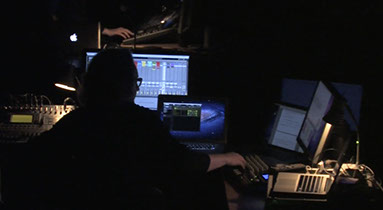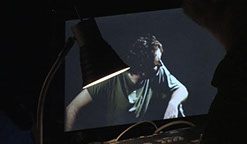Examples
Read more
CHAPTER 5.2.6 - 5.2.8
A work commentary
Kent Olofsson, sound composer on the set, is the one who describes and interprets them. He plucks their words from the air, and gives them different timbres, a new articulation. Language becomes syrup, like ghosts in a dense fog. Once in a while, Olofsson literally twists the words, as when Hamlet appeals to his mother. The scene becomes an echo chamber, the resonant space of two souls who have delved deeply into themselves.
Their echoes not only play on your feelings, they also harmonize with the repetitive replies that Hamlet and Ophelia each voice. Every statement, every approach, every promise renews itself, impinges upon the other and vanishes. It is a repetition such as in a maze. Everything seems to double itself, and to appear different yet again. Nothing is certain.
(Wouter Hillaert in a work commentary for the performance at Kunstenfestivaldesarts, Brussels 2012)
EXAMPLE 5.2.6. Video: Performance, scene 6 start
2 Mom? Gertrude? Gertrude? Can you hear me? Can you hear that I’m calling that I’m calling your name? Mom? Can you hear me? Can you hear that I’m your name? That I’m calling your name? Can you hear that? Gertrude? Edurtreg? Edurtreg?
1 Here I am.
2 No, it’s not you, mom. That’s not you.
1 I’m mom.
2 No, no, you’re not my mom. You’re not her.


As in Indy 500: seklernas udde, the construction of musical instruments was also a crucial part of the composition process of Hamlet II: Exit Ghost. In this work, however, I built the setup of electronic instruments for myself to compose and perform on. In Indy 500: seklernas udde I composed by trying out sonic ideas and playing techniques on the instruments, both the acoustic and electronic, which I then communicated to the musicians of the ensemble through the score, the demo recording and verbal playing instructions. In Hamlet II: Exit Ghost I never wrote a score or any other detailed instruction that could be used to perform the music. The process of composing and the performance were both totally integrated and embodied activities.
EXAMPLE 5.2.7. Video: Performance, transition between scene 4 and 5
The music for Hamlet II: Exit Ghost was created more or less entirely during the collaborative dramaturgical process and in the rehearsals with the actors and the director. Both individual sounds and musical sections were tried in immediate interaction with the actors. In some sections I processed the voices of the actors with different electronic effects, like in the opening section the voice of the male actor is gradually distorted and fragmented through different sound processing techniques.
EXAMPLE 5.2.8. Sound: Performance, from scene 1a

